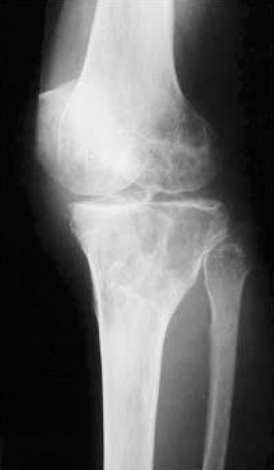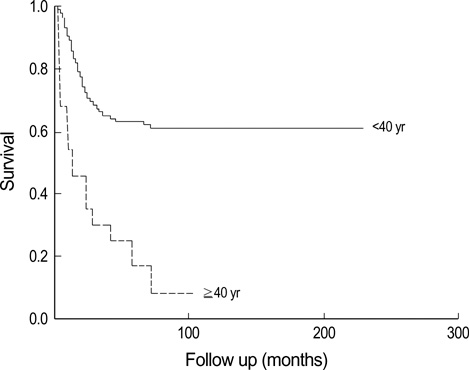J Korean Med Sci.
2006 Aug;21(4):715-718. 10.3346/jkms.2006.21.4.715.
Primary Osteosarcoma in Patients Older than 40 Years of Age
- Affiliations
-
- 1Department of Orthopaedic Surgery, Korea Cancer Center Hospital, Seoul, Korea. pjh1964@hanmail.net
- KMID: 2157826
- DOI: http://doi.org/10.3346/jkms.2006.21.4.715
Abstract
- Among the 665 patients who registered at our hospital, we reviewed 39 cases of high grade primary osteosarcoma in patients who were older than 40 yr of age. The aim of this study was to determine if a primary osteosarcoma in older patients has different clinical features, and a poorer prognosis than in younger patients. Two evaluations were performed. In the first, an attempt was made to determine the possible prognostic factors such as gender, location, size, alkaline phosphatase, radiological findings, chemotherapy intensity, chemotherapy-induced tumor necrosis, and surgical margin. The second evaluation involved assessment of whether there were any significant clinical differences between older patients and adoles-cents. According to the results, a primary osteosarcoma in older patients did not reveal any significant prognostic variables. A primary osteosarcoma in older patients showed a poorer prognosis due to relatively unusual locations, common abnormal radiological findings, and a poor response to chemotherapy. Therefore, careful attention should be paid to making an accurate diagnosis and new strategies for more effective treatment, including chemotherapy, must to be developed in order to achieve long term survival in older patients with osteosarcoma.
Keyword
MeSH Terms
Figure
Cited by 1 articles
-
Pathologic Fracture in Radiation-induced Osteosarcoma Misdiagnosed as Delayed Femoral Neck Fracture
Young Soo Chun, Chung Soo Han, Sang Joon Kwak, Dong Bum Huh
J Korean Orthop Assoc. 2011;46(3):250-255. doi: 10.4055/jkoa.2011.46.3.250.
Reference
-
1. Gurney JG, Severson RK, Davis S, Robison LL. Incidence of cancer in children in the United States. Sex-, race-, and 1-year age-specific rates by histologic type. Cancer. 1995. 75:2186–2195.
Article2. Grimer RJ, Cannon SR, Taminiau AM, Bielack S, Kempf-Bielack B, Windhager R, Dominkus M, Saeter G, Bauer H, Meller I, Szendroi M, Folleras G, San-Julian M, Eijken JV. Osteosarcoma over the age of forty. Eur J Cancer. 2003. 39:157–163.
Article3. Huvos AG. Osteogenic sarcoma of bones and soft tissue in older persons. A clinicopathologic analysis of 117 patients older than 60 years. Cancer. 1986. 57:1442–1449.4. Rosen G, Caparros B, Huvos AG, Kosloff C, Nirenberg A, Cacavio A, Marcove RC, Lane JM, Mehta B, Urban C. Preoperative chemotherapy for osteosarcoma. Selection of post-operative adjuvant chemotherapy based on the response of the primary tumor to preoperative chemotherapy. Cancer. 1982. 49:1221–1230.5. Enneking WF. A system of staging musculoskeletal neoplasms. Clin Orthop Relat Res. 1986. 204:9–24.
Article6. Stark A, Kreicbergs A, Nilsonne U, Silfversward C. The age of osteosarcoma patients is increasing. An epidemilolgical study of osteosarcoma in Sweden 1971 to 1984. J Bone Joint Surg. 1990. 72B:89–93.7. Naka T, Fukuda T, Shinohara N, Iwamoto Y, Sugioka Y, Tsuneyoshi M. Osteosarcoma versus malignant fibrous histiocytoma of bone in patients older than 40 years. A clinicopathologic and immunohistochemical analysis with special reference to malignant fibrous histiocytoma-like osteosarcoma. Cancer. 1995. 76:972–984.
Article8. Okada K, Hasegawa T, Nishida J, Ogose A, Tajino T, Osanai T, Yanagisawa M, Hatori M. Osteosarcomas after the age of 50: a clinicopathologic study of 64 cases; an experience in northern Japan. Ann Surg Oncol. 2004. 11:998–1004.9. Rhee SK, Woo YK, Kang YK, Song SW, Chung YG, Lee AH, Yoo JY, Chung DH. Osteosarcoma in patients older than 40 years. J Korean Bone Joint Tumor Soc. 1999. 5:169–177.10. Bacci G, Picci P, Ferrari S, Orlandi M, Ruggieri P, Casadei R, Ferraro A, Biagini R, Battistini A. Prognostic significance of serum alkaline phosphatase measurements in patients with osteosarcoma treated with adjuvant or neoadjuvant chemotherapy. Cancer. 1993. 71:1224–1230.
Article11. Thorpe WP, Reilly JJ, Rosenberg SA. Prognostic significance of alkaline phosphatase measurements in patients with osteogenic sarcoma receiving chemotherapy. Cancer. 1979. 43:2178–2181.
Article12. Wang YM, Sutow WW, Romsdahl MM, Perez C. Age-related pharmacokinetics of high-dose methotrexate in patients with osteosarcoma. Cancer Treat Rep. 1997. 63:405–410.13. Kimmick GG, Fleming R, Muss HB, Balducci L. Cancer chemotherapy in older adults. A tolerability perspective. Drugs Aging. 1997. 10:34–49.
- Full Text Links
- Actions
-
Cited
- CITED
-
- Close
- Share
- Similar articles
-
- Development of Conventional Osteosarcoma after 13 Years Continuous Disease-free Survival of Periosteal Osteosarcoma
- Osteosarcoma of the Metacarpal Bone
- Primary Osteosarcoma of the Breast: A case report
- Primary Renal Osteosarcoma Presenting as Hydronephrotic Kidney: A Case Report with Imaging Findings and a Literature Review
- Osteosarcoma in Korean children and adolescents



